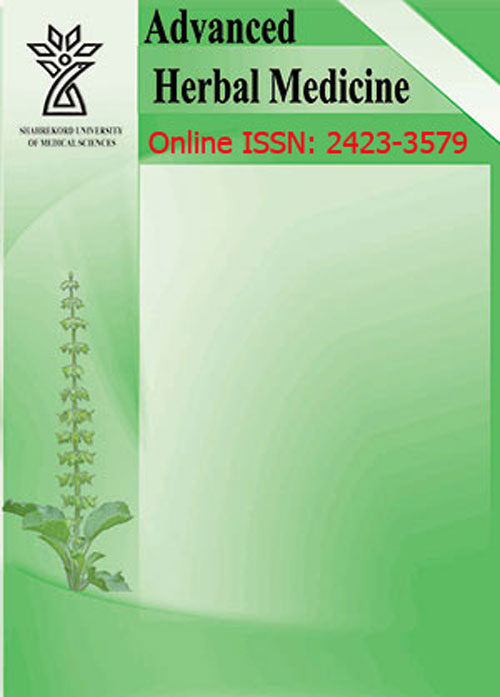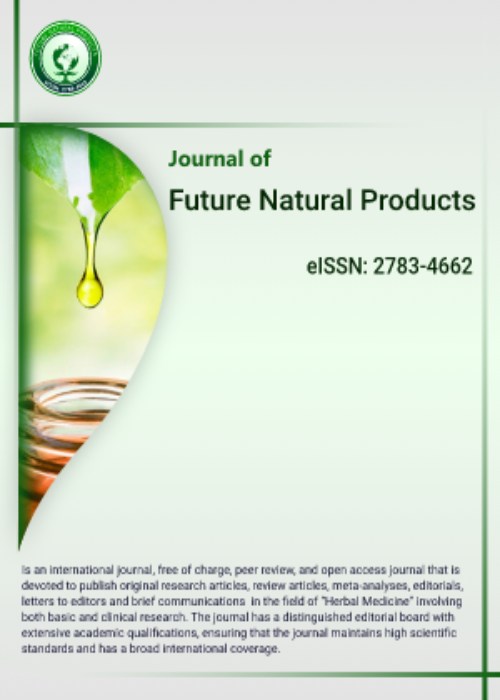فهرست مطالب

Future Natural Products
Volume:1 Issue: 2, Spring 2015
- تاریخ انتشار: 1394/02/11
- تعداد عناوین: 8
-
Pages 4-10Background And AimsIschemic stroke is the most common type of stroke and its most important symptoms are paralysis and movement disorders. Therefore, finding a method for treating this disorder is greatly important. This study was conducted to investigate the clinical efficacy of frankincense on the patients with ischemic stroke.MethodsIn this clinical trial study, 60 patients with ischemic stroke were randomly assigned into two groups of treatment and control (30 patients in each group). In the treatment group, in addition to the routine treatment of stroke, four capsules containing 500 mg of powdered frankincense were used daily, but in the control group, only the treatment of stroke (without frankincense) was implemented. Treatment continued for one month. NIHSS questionnaire (to assess speech and muscle strength) was completed at the baseline, on the seventh day and at the end of treatment for each patient. In this study, statistical analysis was carried out by t- test, chi-square and Mann-Whitney using SPSS software.ResultsThe results showed that only in the second step in the treatment group, the rate of recovery of the left lower and muscle strength of upper limbs was significantly increased in patients compared to the control group.ConclusionIntroducing frankincense into treatment for stroke patients can contribute in improving muscle strength of the patients with muscle weakness in non-dominant hemisphere in acute phase of neurological disorder, while it has no effect improvement of muscle strength of right limbs or speech.Keywords: Stroke, Frankincense, Movement disorder, Speech disorder
-
Pages 11-16Background And AimsAlzheimer''s disease is a progressive disorder of nervous system that leads to dementia in patients. This study was conducted to determine the effect of combination of honey, saffron (Crocus sativus L.) and sedge (Cyperus rotundus L.) on cognitive dysfunction in patients with Alzheimer’s disease.MethodsThis double-blinded clinical trial study enrolling a sample size of 30 subjects was conducted per cross-over method. The patients with mild Alzheimer''s disease obtaining the scores 12 ≥ in cog-ADAS scale were enrolled into the study. The participants were randomly assigned into two groups of A and B. During the first 2 months in group A, placebo was given, and group B underwent treatment with the combination under study. After a one-month period of washout, the same procedure was run reversely in two groups. Finally, the data analysis was done by SPSS software using descriptive and analytical tests.ResultMann-Whitney test indicated no difference in mean cognitive dysfunction between two groups in neither of periods (P>0.05). Also, Friedman test showed no change in cognitive dysfunction during the study in neither of groups (group A: P=0.287, group B: P=0.158).ConclusionSimultaneous use of honey, C. rotundus and C. sativus has no more pronounced effect than placebo on cognitive dysfunction in patients with mild to moderate Alzheimer''s disease. It is recommended that future studies of this compound be done on patients of younger age and its preventive effects be addressed.Keywords: Alzheimer's disease, Cyperus rotundus, Crocus sativus, Honey
-
Pages 17-22Background And AimsExamination score is important for destination of students due to educational and occupational issues. This study was conducted to investigate the effect of inhaling the vapor of lavender on summative examination scores in nursing students.MethodsThis single-blinded randomized controlled clinical trial was conducted on 33 nursing students at summative examination session of public health course. The intervention group (n=16) breathed vapor of lavender and the control group (n=17) breathed water vapor for 30 minutes just before the exam and after intervention, the examination scores (0-20) were compared. To analyze the findings, the SPSS software 18 and statistical tests including Spearman’s correlation coefficient, Pearson correlation coefficient, Mann–Whitney U test and independent sample t-test were used.ResultsThe demographic variables as well as the mean of examination scores were not significantly different between two groups (P>0.05). There were no correlations between examination score and age, sleep time, gender, marital status, and parents’ education level of the students.ConclusionAlthough aromatherapy with lavender, as administered in this study, does not affect examination score of students, regarding that the students reported aromatherapy as pleasant; It suggests it is used in examination session as an easy method to apply.Keywords: Lavender, Examination score, Student, Nursing
-
Pages 23-33Background And AimsUrtica dioica as a medicinal herb due to its anti-inflammatory, antioxidant and hypoglycemic effects, improve type 2 diabetes and decrease inflammation, fibrosis and necrosis as the signs of Nonalcoholic steatohepatitis. Polycystic Ovary Syndrome (PCOS) as the most important factor of infertility has an overlap of 30 % to 60% with liver disorders. Hence, the Urtica dioica moderator effect on liver function in PCOS rats was examined.MethodsIn this experimental study 144 adult Wistar rats were divided into control, PCOS and nettle-treated groups. The group PCOS was injected subcutaneously 2 mg estradiol valerate, after 60 days and confirmed polycystic, the experimental group was injected intraperitoneally the Urtica dioica extract doses (150,250, 450 mg/kg BW). After 21 days, rats were anesthetized by chloroform; blood samples and livers were collected for histological and serological evaluation. Data were analyzed using in stat 3 via one-way ANOVA and P<0.05 was considered statistically significant.ResultsLiver sections and serological analysis showed reduced number of necrotic cells, insulin resistance index and lipid profile in PCOS rats that were treated with various concentrations of Urtica dioica extract.ConclusionWhereas PCOS is described as a low-grade inflammatory state, the results show that Urtica dioica by increasing insulin sensitivity and reducing hepatic necrosis may reduce inflammation and improve metabolic symptoms in PCOS and has significant protective effect on liver.Keywords: Urtica dioica, Polycystic ovary syndrome, Liver, Necrosis, Insulin resistance
-
Pages 34-39BackgroundThe 4T1 cells tumor growth and metastatic pattern in BALB/c mice very closely mimic human breast cancer. These herbal remedies used in traditional folk medicine have been the source of many medically beneficial drugs. The aim of the current study was to evaluate the anti-proliferative activity of the asafoetida, ginseng and fennel ethanolic extracts on mouse breast cancer 4T1 cell-line invitro.Methodin this experimental study, Asafoetida, gensing and fennel were extracted; 4T1 mouse mammary tumor cell line were cultured in 48-well flat bottom plate in density of 50x103 per well in 100 µl RPMI1640 medium then different dilutions of each extract (25, 50, 100, 200, 500, and 2000 μg/ml) were added to cell culture. Cells then were incubated at 37 oC for 24 hours. After 24 h, cell Proliferation was determined by the BRDU assay.ResultsMouse breast cancer 4T1 cell line was incubated with different doses of extracts. After 24h, cell proliferation was determined by the BrdU assay and the dose of 50μg/ml of fennel showed the best inhibitory effect.ConclusionAnti-tumor activities of fennel, asafetida and ginseng ethanolic extracts may decrease proliferation activity of 4T1 cell line in vitro. The results suggested that fennel, asafetida and ginseng ethanolic extracts induce apoptosis and inhibit cell proliferation in vitro and fennel had the best anti proliferation effect.Keywords: Fennel, Asafetida, Ginseng, 4T1 Cell line, Breast cancer
-
Pages 40-53Background And AimsKombucha is an ancient food and healing source with Asian origin. Kombucha consists of a wide range of acids, including vitamin C, organic materials, enzymes, and B-group vitamins, which has provided it with immense value. This study was aimed to investigate the effects of Kombucha tea consumption on hepatic UDPGT enzyme in mice.MethodsIn this experimental study, 21 small male albino mice and CD-1 genus were used. Albino mice species were purchased from serum Institute in Karaj Hisarak. Mice with a weight between 18 to 25 g were selected. Animals were kept in triplex group in polycarbonate cages. Animal rooms were equipped with air-conditioner. Ambient temperature was retained at about 22°C, and humidity 50%. A light cycle was set at 12 hours brightness and 12 hours darkness. The intensive diet was used that produced by animal Pars feeds for mice feeding. Finally, UDPGA enzyme was measured.ResultsConsumption of kombucha tea for seven days of experiment caused a significant increase in enzyme activity in mice liver UDPGT compared to the negative control group, from the first day until the seventh day of experiment.ConclusionKombucha tea induced the UDPGT enzyme; thus, it accelerated the detoxification of the body and should be cautioned about simultaneous administration of this beverage with some drugs (such as steroids, acetaminophen, cardio– vascular medicine, etc.) that they metabolize through conjugation. Medical community in this case must be justified and their opinion must be considered when people are using this tea. Finally, kombucha tea consumption did not increase the liver weight. So, UDPGT induction was not the reason of liver weight increase.Keywords: Kombucha, Liver, UDPGT, Mice, Iran nonpharmacologic nursing care
-
Pages 54-63Background And AimsSea buckthorn (Hippophae rhamnoides L.) is a deciduous plant and has highly variable type and size, from small shrubs to medium-sized trees, traditionally growing in Tibet and currently all over the world especially in Europe and Asia. This study aimed to overview some of therapeutic and non-therapeutic properties of SBT and its potential benefits and side effects in order to open up a clear understanding for further detailed study in this regard.MethodsThis review article was carried out by searching studies in Web of Science, Google Scholar, PubMed and ScienceDirect. The search terms were “Sea buckthorn”, “Sea buckthorn” and “hippophae”, “therapeutic”, “non-therapeutic”.ResultsVarious studies have shown that sea buckthorn plays a role in the treatment of cardiovascular disease, liver fibrosis, skin diseases (eczema, acne,), arthritis, vaginal atrophy, dry eye. This herb has anti- inflammatory, anti-constipation, antioxidant, anti-aging, anti-cancer, anti-stress, antidepressant and antiproliferative effects. Besides, it enjoys some non-therapeutic properties including nutritive values (a good source of vitamin C, E, omega 3, 6, 7), oral and dental health care value and cosmetic value (in the industry of cosmetics: cream, shampoo, jellies, and etc.).Conclusionsea buckthorn is widely used for therapeutic and non-therapeutic purposes that trigger its significant value. Various combinations and numerous medicinal properties of its berries, fruits, extract, pulp, seed oil, leaves demand further and more studies about the other useful and unknown properties of this multifunctional plant.Keywords: Medicinal plants, Sea buckthorn, Hippophae, Therapeutic effects, Non, therapeutic effects


